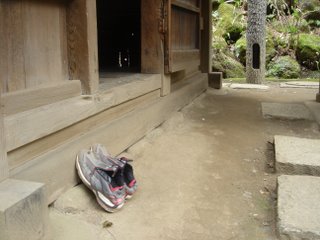I have to thank both Ota and Lyanka for many of the insights contained herein; I am little more than a synthesiser of their collective brilliance.
All three of these types of traditional footwear are in the sandal family. Waraji are the forerunners of Birkenstocks: sandals made of hemp or straw. Zori are closer to flip-flops, lower and lighter than waraji, and with cloth straps instead of straw or hemp ones. Geta can best be described as platform sandals; they are basically a thick block of wood on short stilts, with cloth straps on top to bind the whole thing to the foot. Geta were excellent for the upper classes in feudal Japan, who wanted to keep their colourful kimono and yukata out of the muddy streets when they strolled about town, lording it over the commoners.
But why are all three forms of Japanese traditional footwear a type of sandal (i.e. having no back and attached to the foot only by two straps starting in the back third of the sandal and meeting between the big toe and the second toe of the wearer)? The answer is rather simple: the Japanese have not worn shoes in their houses since time immemorial. Westerners who have ever visited a Japanese friend (or even one of those new age hippy types who asks you to take your shoes off inside the door) know what a pain it is to take off your Western-style shoes when you come in, then put them back on when you leave. Or, if you are one of those new age hippy types or a Westerner who has lived in Japan and thus thinks it is a wonderful idea to ban shoes from the house (Ota and I rolled that way back in uni), you know what a pain it is to deal with your footwear, especially if you are going in and out a lot, carrying groceries in or some such.
One benefit of sandals is that they are very easy to take on and off, so they suited the Japanese lifestyle perfectly. You'd roll up to your house (or someone else's, if you were visiting), pause a moment in the genkan, turn around so your back faces into the house, and simply step out of your footwear and up into the house. Japanese houses have elevated floors, but genkan, or entranceway, is at street-level. And that is where you leave your shoes whilst inside the house.
When the Japanese started wearing Western-style footwear (i.e. shoes that enclose the entire foot and not just the bottom), they did not do away with the tradition of leaving their shoes in the genkan. Instead, they came up with a very Zen solution to the problem: allow the shoes to become sandals. Japanese people tend to ignore laces on their shoes--they tie them once, and then never untie them again. When they want to take their shoes off, say in the genkan of a house, they just pull each foot out. When they want to put their shoes back on when heading back outside, they just step down into the shoes, mashing the backs down so they can slip their feet in. At an izakaya, a Japanese beer hall where you usually sit around a lowered table and thus must take your shoes off, it is very common for the restaurant to provide a shoe horn or three, which people will happily use with their tennis shoes (or lace-up Oxfords, in the case of the sarariman), rather than going to the bother of untying and retying them.
 The result of this is that Japanese people's shoes take quite a beating. The backs of the average person's shoes are pretty ravaged, and it is not uncommon to see guys walking around with the heel of their athletic shoes so mashed down that their shoes have essentially become clogs. Seriously, where the back of the shoes should be, you just see the heels of their socks, with the heels of the shoes crunched under the feet. Shoes into sandals, you see. I realise this might be a bit difficult to picture, so please refer to the image at right (and clicky clicky, of course).
The result of this is that Japanese people's shoes take quite a beating. The backs of the average person's shoes are pretty ravaged, and it is not uncommon to see guys walking around with the heel of their athletic shoes so mashed down that their shoes have essentially become clogs. Seriously, where the back of the shoes should be, you just see the heels of their socks, with the heels of the shoes crunched under the feet. Shoes into sandals, you see. I realise this might be a bit difficult to picture, so please refer to the image at right (and clicky clicky, of course).But there is another interesting side-effect of the traditional footwear. You see, when wearing a sandal, having an absolutely perfect fit is not necessary. If your heel and/or toes hang over the edge a bit, or if you have an extra few centimetres of "flip" and "flop" to your step, it is not a big deal. And that mentality has persisted. You often see guys in athletic shoes that are clearly several sizes too big, flopping around like clown shoes. And you also see girls rocking ill-fitting Jimmy Choos or Manolo Blahniks (Manolos? Manonos? I can't tell.). Too big? No problem, let 'er flop. Too small? No problem, let your toes stick out the front. To heighten the comic effect, girls rarely fasten the back strap of their heels (if their shoes have a back strap).
So all shoes are backless in Japan, at least in the mind of the wearer.

2 comments:
I ended up getting laceless shoes like these to deal with the problem of having to take off shoes everywhere.
Extremely well written! Very entertaining and informative. A friend of mine just visited Japan and was curious about the shoe situation. I told her I would check it out for her and behold!, your website. It's so funny because I have never been to Japan, but studied it in Girl Scouting, have always had the decor in my home and have always stepped in and out of my shoes as you described in your article. That is soooo funny to me, especially since I hate shoes and I'm Black. I eat with chopsticks very easily and it's just so funny to me that someone outside of a certain culture can have inherent preferences that resemble a totally different culture than their own. Thanks so much and I'll pass the URL on to my friend. Have a good day and God bless!
Post a Comment